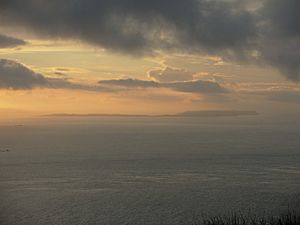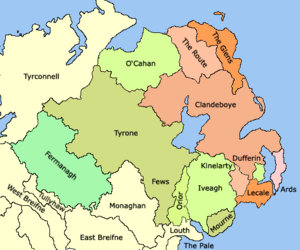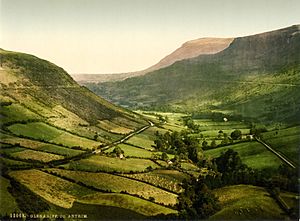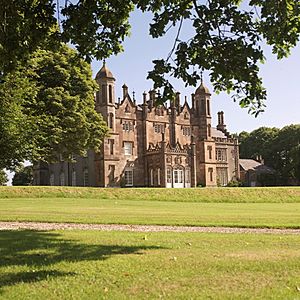Mac Eoin Bissett family facts for kids
| Mac Eoin Bissett |
|||
|---|---|---|---|
Quick facts for kids Arms of Bissett of Beaufort.svg |
|||
| Country: | Gaelic Ireland | ||
| Parent House: | Bissett family | ||
| Titles: | * MacEoin Bissett
|
||
| Founder: | John Byset the Elder | ||
| Founding Year: | 13th century | ||
| Dissolution: | 16th century | ||
The Bissett family in Ireland has a unique story, different from their relatives in Scotland. They arrived in Ulster (a province in Ireland) in the early 1200s. While they still had ties to Scotland, the Bissetts quickly became powerful lords in the Glens of Antrim. They became very much like the native Irish, adopting their customs and language. This process is called Gaelicisation.
The leaders of the family soon took on an Irish name style: Mac Eoin Bissett. This means "Son or Descendant of John Byset", who was an important ancestor from Scotland. In English records, the family head was also known as the Baron Bissett. Over time, this family name led to two modern surnames in County Antrim: McKeon/McKeown (from Mac Eoin) and Bissett. In the Irish language, Bissett is usually written as Bised (Biseid).
Contents
The Bissetts Arrive in Ulster
It's not clear exactly when John Byset and his family came from Scotland. But English records show him in Ireland by 1245. Henry III of England even gave him a gift of money. We can only guess what John Byset did next from a short note in the Annals of Ulster, which reported his death in 1257. This note shows he was a powerful and sometimes harsh leader in the region:

AU1257.1(col. 2): John Bisset, who destroyed churches and Gaidhil, died suddenly.
"Gaidhil" here means the native Gaelic Irish people of Ulster. We don't know if Byset bought his lands or if the English king gave them to him. His relationship with other powerful English and Scottish lords in the area was likely complicated.
After the death of Hugh de Lacy, the first Earl of Ulster, in 1242/3, his power in eastern Ulster was weak. It's possible the Bissetts helped de Lacy against a Scottish rival and got land for it. But there's no clear record of this. In the 1250s, Brian Ua Néill became the strongest king in northern Ireland. He attacked the English earldom, destroying castles and killing many English and Scottish settlers. The Bissetts might have suffered during this time. However, the report of John Byset's death in 1257 suggests the family was still strong. They might have even been the most important British family left in that part of Ulster for a while.
After O'Neill's death in 1260, Walter de Burgh was made Earl of Ulster to protect England's interests. The Bissetts might have had to become his followers. But some historians believe the Bissetts' land was a special "palatine lordship," meaning they had a lot of independent power from the start.
The Bruce Wars and Irish Conflicts
Supporting Robert the Bruce
Historians think Edward Bruce might have spent time with the Bissetts when he was young. In 1305/6, Robert the Bruce, the future King of Scotland, and his followers found refuge at Rathlin Castle. This castle was part of the Bissetts' Lordship of the Glens.
Sir Hugh Bisset, who was likely a son of the Mac Eoin, reportedly welcomed them, even though the English king, Edward I of England, had ordered against it. It was here that Robert Bruce might have planned his fight to regain Scotland. Later, Edward Bruce landed at Sir Hugh's manor of Glenarm after their victory at the Battle of Bannockburn.
The English Parliament sent messages to five Bissett lords when they heard about the Scottish invasion. One of them, John Byset, might have been the Mac Eoin who joined the Scots. The 19th-century scholar Herbert Hore even suggested the Bissetts might have encouraged Edward Bruce to invade Ireland.
Divided Loyalties
We don't have a full family tree for the Irish Bissetts, so their exact relationships and political choices are hard to know. However, Sir Hugh Byset was a very important lord in the region. In 1301, Aonghus Óg of Islay mentioned him in a letter to Edward I as a friend. Hugh Byset's loyalty to the English king was clear. He was often ordered to fight against the English king's enemies in Scotland, especially Robert Bruce. The English Crown even paid for Byset to gather his forces and prepare ships to fight the Scots.
When Edward Bruce invaded Ireland in 1315, Hugh Byset and other lords, both Norman and Gaelic, joined Sir Thomas de Mandeville to oppose him. Bruce landed at Olderfleet Castle, which might have belonged to the Bissett family. Their combined force, which didn't have immediate help from the Earl of Ulster, was defeated by the Scottish army. The Scots then moved south to Carrickfergus.
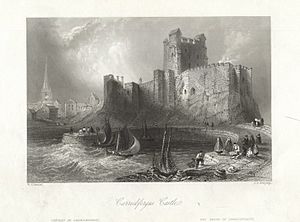
The poet John Barbour wrote about this battle in his epic poem The Brus:
In twa battelis [two battles] thai [Bruce's army] tuk the way
Toward Cragfergus, it to se.
Bot the lordis of that cuntre [country],
Mavndwell, Byset, and Logane,
Thar men assemblit euirilkane [assembled every one of their men];
De Sawagiss wes alsua thair.
And, quhen [when] thai all assemblit war,
Thai war weill neir tuenty thousand.
However, some Bissetts were on the Scottish side. A "Johannes Bisset" (John Bisset) is listed in some old Latin records as one of the Scottish lords with Bruce during the invasion. This John Bisset might have been the Mac Eoin who had gone to Scotland and was now returning. He was a leader in the force that defeated Hugh Byset and his allies. He also fought with Bruce in other victories. This John Bisset seems to have died in February 1316.
Hugh Byset continued fighting for the English side. In November 1316, he and John Logan defeated a Scottish army, killing many soldiers. Despite his support for the English Crown, Hugh Byset's lands, Glenarm and Rathlin Island, were declared lost by the government. This might have been because of a report that "Bisset-men and Logans" helped Bruce, or because Hugh had welcomed Robert Bruce to Rathlin earlier.
The Earldom of Ulster collapsed in 1333. This meant the English government lost direct control over the region for a long time. The Bissetts were then surrounded by powerful Gaelic Irish groups. In 1338, Hugh Byset's friend, John of Islay, Lord of the Isles, asked Edward III of England to give back lands in "Glynarvie" (Glenarm) to Byset. Edward III agreed, recognizing Byset's service against the king's enemies. John of Islay even called Sir Hugh his relative.
The Mac Eoin and the O'Neills
The Bissetts first clear contact with the powerful O'Neill dynasty was in 1287. At this time, the Bissetts were still part of the Earldom of Ulster. But this is also the first time the Gaelic title "Mac Eoin" is used for the Bissetts. This shows that the family had already adopted many Irish customs and language.
AU1287.2: A host was led by Richard de Burgh namely by the Earl of Ulster (that is, the Red Earl) into Tir-Eogain, whereby he deposed Domnall, son of Brian Ua Neill and Niall Culanach O'Neill was made king by him. And when the Earl left the country, Niall Culanach was killed by Domnall Ua Neill. And the son of Aedh Ua Neill the Tawny (namely, Brian, son of Aedh the Tawny) was made king, with the assent of the same Earl, by Mac Martin and by Mac Eoin. And Domnall left the country.
There are no records of the Mac Eoin Bissetts for almost a century after this. The Earldom of Ulster became very weak after the murder of William Donn de Burgh in 1333. We don't know what the Bissetts did during this time. But by 1383, they were likely allied with the O'Neills against the remaining English lords, like the Savage family. In that year, Niall Mór Ó Néill, the King of Ulster, attacked the English in northern Ireland. After one battle, Seinicin Finn Bissett, a son of the Mac Eoin, killed a wounded enemy, Raibilin Savage. In revenge, Savage's people killed Bissett.
The Bissetts were now formally allied with the O'Neills. This is supported by records from 1387 that mention the death of Sabia O'Neill (Sadhbh inghen Aodha Uí Néill), the wife of the Mac Eoin Bissett. She was praised as a wonderful lady of the O'Neill family. She was the daughter of an Aodh Ó Néill, but it's not clear which one.
More evidence of Bissett support for the Irish Gaels against the English comes from 1403. A "MacGion" who fought on the Gaelic side in a conflict is thought by historian Kenneth Nicholls to be the Mac Eoin Bissett.
"English Rebels" in Ireland
In 1515, before the Tudor conquest of Ireland, a list was made for Henry VIII of England. It named the most powerful families in Ireland who were not under English control. These included both Gaelic families and Norman families who had become like the Irish. The Bissetts were listed among these "English rebels" in Ulster:
... Also, ther is more than 30 greate captaines of thEnglyshe [Anglo-Norman] noble folke, that folowyth the same Iryshe ordre, and kepeith the same rule, and every of them makeith warre and pease for hymself, without any lycence of the King, or of any other temperall person, saive to hym that is strongeyst, and of suche that maye subdue them by the swerde. Ther names folowyth immedyat: (They are listed by Irish province. Reaching Ulster, the Bissetts are one of the only three listed.) ... Here folowyth the names of the great Englyshe rebelles of Wolster. Syr Rowland Savage, of Lecchahyll, Knight. Fitzhowlyn, of Tuscarde. Fitz John Byssede, of the Glynnes.
Later in the same document, Ulster is discussed again, mentioning four Anglo-Norman families:
... Hereafter folowyth the names of the thEnglyshe rebelles, dwelleing within the sayd countye of Wolster. Syr Roland Savage, and his kynnesmen. The Baron Russell, and his kynnesmen. Fytzjohn, Lorde of Glynnes, and his kynnesmen. Fythhowlyn, Lord of Tuscarde, and his kynnesmen. Also, that the Deputye, and the sayd captayne, Sir Rowland Savage, and his kennesmen in the baronye of Mawlyn, and in all the landes marcheing with the sayd baronye of Tuscard, and with the baroyne of the Glynnes, and to ayde and succourre them.
Another similar list from around 1540, called the Book of Howth, also mentions them:
... Those English noble and worshipful captains was degenerate from the English laws: (again they are listed by province) ... Wlster: Savadge of Lekayle, Knight, FitzOwlyn of Twskard, Bysetes of the Glyns.
The term "Captains" was important. It meant these families had almost total control over their lands, even if they weren't huge. They were like the Gaelic Irish lords, making their own wars and peace. This was sometimes called becoming "more Irish than the Irish themselves". The Bissetts were among those who had adopted Irish ways. We don't know what happened to them after this, as they seem to have lost their power before the Kingdom of Ireland was fully established.
Losing the Lordship
The last mention of the Mac Eoin Bissett family in Irish and English records is from the Battle of Knockavoe in 1522:
AC1522.7: ... But as for O Domnaill and the Cenel Conaill, since they had not warriors enough or a force to give battle to either of those two armies, he and his nobles determined to make a night attack on O Neill and his host. They dismounted their horsemen and added them to their battalions [of foot] and, O Neill being encamped at Knockavoe, the Cenel Conaill attacked them of one accord, without help of neighbour or friend. O Neill was defeated that night and many of his followers, both Scotch and Irish, were killed, more especially the Galls and the Leinster gallowglasses. Mac Eoin of the Glens and many other Scots and a great number of the Clann Domnaill Galloclaech and of the Clann Sithig were killed there, and O Neill went away as a defeated man after the slaughter of his followers.
It's believed that soon after this battle, the MacDonnells, who were once friends and allies of the Bissetts, took over the Lordship of the Glens.
Just ten years before, in 1512, the Bissett lordship was weakened by an invasion from Gerald Mór FitzGerald, 8th Earl of Kildare. He destroyed the Mac Eoin's castle and plundered the Glens. This came after another misfortune in 1495. The O'Donnells from the west raided the Mac Eoin's lands. According to the Annals of the Four Masters, they captured him, his wife, horses, and a valuable hound. This account, however, might be biased as it was written by O'Donnell scholars.
Margery Byset and the MacDonnells
The MacDonnells' claim to the Glens of Antrim came from the marriage of Margery Byset, a daughter of the Mac Eoin, to John Mór MacDonnell in the 1390s. He was the second son of John of Islay, Lord of the Isles. From this marriage, or soon after, John Mór and his descendants, the Clan MacDonald of Dunnyveg, considered the Glens their own. They called themselves lords of "Dunnyveg and the Glens" by 1403.
However, the Bissett family's male line was still strong. It's not clear how much control the MacDonnells actually gained at this time. Some historians believe the Bissetts' dislike of the MacDonnells might have led to an alliance between the MacDonnells and the Savage family. The fighting by Mac Eoin Bissett against the English of Ulster in 1403 might be linked to MacDonnell's new title.
Historians have different opinions. W. F. T. Butler thought the MacDonnell claim was doubtful. George Hill believed they didn't really establish themselves in the Glens until Alexander Carragh in the early 1500s. Alexander Carragh was a strong leader. It was in this decade that the Bissetts seem to have lost control of their lordship after the Battle of Knockavoe.
One of Alexander Carragh's sons, the famous Sorley Boy MacDonnell, was allowed by Elizabeth I of England in 1560 to rent the lands he claimed "by inheritance." But the MacDonnells still struggled because of Shane O'Neill, a powerful Irish prince who constantly bothered them. After O'Neill's death, Sorley Boy asked again in 1573 for "a portion of the Glynns claimed by him by inheritance from the M[B]issetts." The government thought this was a good idea, hoping to use him against the Irish who refused to surrender.
However, Sorley Boy soon got into a big fight with the English. He ended up settling in The Route, an old lordship west of the Glens. In 1584, a younger brother, Donnell Gorme MacDonnell, swore loyalty to Elizabeth for "so much of the Glynns in Ulster as were the lands of Myssett, otherwise Bissett." He agreed to pay yearly rents. In 1586, just before a treaty allowed the MacDonnells to stay in Ireland, the lordship was granted to Angus MacDonnell of Dunnyveg, another relative of Sorley Boy. This grant included all its castles and "Myssett alias Byssett's lands," except Olderfleet Castle, which became the Queen's property.
Description of the Glens in 1586
In 1586, Sir Henry Bagenal described the Glens in his Description and Present State of Ulster:
... so called because it is [they are] full of rockie and woodie dalles [dales], it [they] stretchethe in lengthe 24 miles (on the one side beinge backed with a very steepe and bogie [boggy] mounteyne and on th' other parte with the sea) on whiche side there are many small creekes betwene rockes and thickets, where the Scottish gallies [galleys] do commonlie land; at either end are very narrowe entries and passages into this countrey, which lieth directlie opposite to Cantire in Scotland, from which it is 18 miles distant.
The Glens contained seven baronies (areas of land), including Larn, Park, Glenarm (the main seat of the lordship), Redbaye, Lade, Cary, and Mowbray. Rathlin Island was counted as an additional half barony. These lands were understood to be:
... some tyme th' enheritance of the Baron Myssett, from whom it discended to a daughter who was married to one of the Clandonells in Scotland, by whom the Scotts now make their clayme to the whole, and did quietlie possesse the same for many yeares, till now of late (beinge spoyled of their goodes), they were totalie banished into Scotland...
It's not clear if "quiet possession" refers to the MacDonnells' control or the period when the Bissett family still held most of the lordship.
The Earldom of Antrim
The MacDonnells continued to claim the Glens of Antrim in the 1600s, based on their "inheritance" from Margery and the Baron (Mac Eoin) Bissett. In 1603, Randal MacDonnell, Sorley Boy's son, received a grant for the Glens and The Route. He was made Viscount Dunluce in 1618 and then the 1st Earl of Antrim in 1620.
In 1569, an Act of Parliament officially gave the "Baron Bissett's land" to the Crown of England. But in 1617–18, the MacDonnells' claim to it as "heirs unto Bissett" was still important. The new Viscount Dunluce's family tree was even recorded:
... Eoin More or Eoin the Great, whose mother was Margaret Stuard, daughter to Robert King of Scotland, and whose wife was Mary Bised that was heir of the seven troohes of Glinnes, whereof Rachroin was parcel. This Donell Ballagh died seized of the seven troohes or cantreds of the Glinnes, in the year 1476, & c.
Domhnall Ballach, the son of John Mór and Margery, lived in Scotland. He is not recorded as owning any part of the Glens when he died in 1476. His son, John Mor (II) MacDonnell, also lived in Scotland. But his son, Alexander Carragh, was likely the one who finally pushed the Bissetts out of the Glens in the 1520s.
Modern Descendants
The Earldom of Antrim still exists today, though it's much smaller. It is held by descendants of Lady Margery and the Mac Eoin Bissetts. The MacDonnell family's old Gaelic title, "MacDonnell of the Glens," has also been revived by another MacDonnell descendant.
There's a local story that a ghost named Ann Bissett haunts Glenarm Castle. She is said to appear only to non-MacDonnells because of the difficult history between the two families.
A Possible Greek Origin?
While a family tree for the Irish Bissetts doesn't survive, Duald Mac Firbis, in his book Leabhar na nGenealach, wrote about the MacDonnells' family history:
Eoin [Mac Donnell], who is also called Eoin a Hile and Eoin Mor, the second son of Eoin, son of Aongus Oge, had to wife Maria Bised, daughter of Mac Eoin Bised, (a Greek family which came in with the conquest of William the Conqueror;) and it was by her that the seven lordships of the Glenns came to the Mac Donnells...
This passage also incorrectly states that the MacDonnells had owned the Glens for 227 years by 1649. But it's the only surviving mention of a tradition from before the mid-1600s that the Bissetts might have been a "Greek family." Duald Mac Firbis simply wrote down the family histories and traditions he found.
Historian John O'Donovan wondered if "William the Conqueror" should actually mean "William the Lion" (a Scottish king). It's known that William the Lion brought many Norman families to Scotland. The first known Byset in Scotland, Henricus Byset, was recorded around 1198. The Bissetts are usually considered a Norman family, even if their origins before that are unclear. Edmund Chisholm-Batten took the Greek origin story seriously. He noted that the arms of a Byzantine Greek family called Dassiotes were similar to the Bissetts'. He also suggested the name might come from the Greek word Βυσσητòς, meaning "fine linen".
See also
- Clan Bissett
- Bissett (surname)


